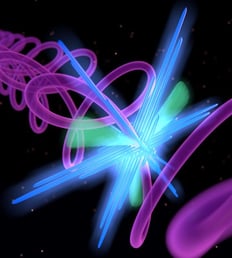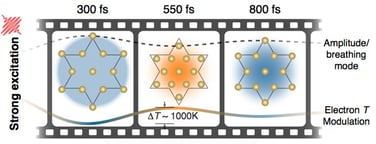Attosecond Nonlinear Optics
Spin Dynamics
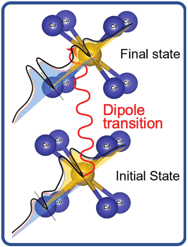 Background: Magnetism has been the subject of scientific inquiry for more than 2000 years. However, it is still an incompletely understood phenomenon. The fundamental length and time scales for magnetic phenomena range from Å (exchange lengths) and sub-femtoseconds (exchange splitting) on up. Furthermore, a detailed understanding of nanoscale magnetism is critical in the 21st century with dramatic increases in data usage and the the critical need for faster, energy-efficient nanodevices.
Background: Magnetism has been the subject of scientific inquiry for more than 2000 years. However, it is still an incompletely understood phenomenon. The fundamental length and time scales for magnetic phenomena range from Å (exchange lengths) and sub-femtoseconds (exchange splitting) on up. Furthermore, a detailed understanding of nanoscale magnetism is critical in the 21st century with dramatic increases in data usage and the the critical need for faster, energy-efficient nanodevices. Time, Angle-Resolved Photoelectron Spectroscopy (ARPES)
Background: High harmonics are ideal as the illumination source for time- and angle-resolved photoemission spectroscopy (trARPES), which can measure the full electronic band structure of a material. Moreover, a new generation of ultrafast (~50-100fs), MHz rep rate, VUV (1-20eV) highly-cascaded high harmonics driven by compact fiber lasers have 10-100meV energy resolution, and are ideal for spin-resolved ARPES (Optica 7, 832 (2020)).
Recommended Sources: Hyperion VUV and Pantheon.
Specifications: multi-kHz to MHz rep rate; 6 to 80 eV; 10 - 300 fs; 40 - 1300 meV linewidth; 1010 - 1014 ph/s flux.
Webinar: Replay talk from Henry Kapteyn and Margaret Murnane.
Nanoimaging
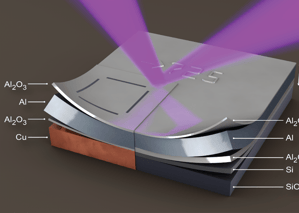 Background: Although x-ray imaging has been explored for decades, and visible-wavelength microscopy for centuries, it is only recently that the spectral region in between―the extreme ultraviolet (EUV)―has been explored for imaging nanostructures and nanomaterials. With the practical implementation of coherent EUV light sources based on high harmonic generation (HHG), combined with coherent diffractive imaging (CDI), we have shown that EUV imaging has unique advantages.
Background: Although x-ray imaging has been explored for decades, and visible-wavelength microscopy for centuries, it is only recently that the spectral region in between―the extreme ultraviolet (EUV)―has been explored for imaging nanostructures and nanomaterials. With the practical implementation of coherent EUV light sources based on high harmonic generation (HHG), combined with coherent diffractive imaging (CDI), we have shown that EUV imaging has unique advantages.
Recommended Sources: Hyperion VUV and Pantheon.
Specifications: multi-kHz to MHz rep rate; 6 to 80 eV; 10 - 300 fs; 40 - 1300 meV linewidth; 1010 - 1014 ph/s flux.
Nanoscale Energy Transport
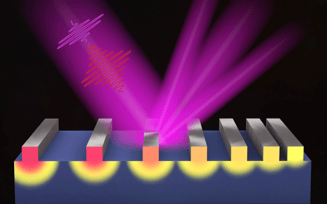 Background: Heat transport is driven by a thermal gradient, flowing from hot to cold regions in a material. However, at dimensions < 100 nm, bulk models no longer accurately predict the transport properties of materials. Because no complete models of nanoscale heat transport were available, many researchers assumed instead that bulk-like diffusive heat transport was valid – provided that an effective parameter, such as a size-dependent thermal conductivity, was incorporated. Such a simple model makes it challenging to implement smart predictive designs for thermal management in nanodevices.
Background: Heat transport is driven by a thermal gradient, flowing from hot to cold regions in a material. However, at dimensions < 100 nm, bulk models no longer accurately predict the transport properties of materials. Because no complete models of nanoscale heat transport were available, many researchers assumed instead that bulk-like diffusive heat transport was valid – provided that an effective parameter, such as a size-dependent thermal conductivity, was incorporated. Such a simple model makes it challenging to implement smart predictive designs for thermal management in nanodevices.
Nanoparticle Dynamics
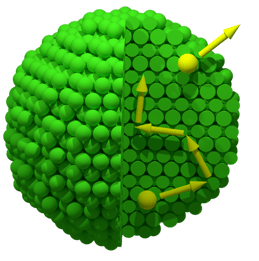 Background: Nanoparticles exhibit a surface-area-to-volume ratio many orders of magnitude higher than bulk materials, allowing them to serve as powerful catalysts for chemical reactions, both in the laboratory and as atmospheric aerosols. Such surface-catalyzed chemical reactions often involve molecular motions that take place on femtosecond and picosecond timescales, with associated electronic dynamics that can occur on attosecond time scales. To capture and understand these dynamics, new experimental techniques are needed to probe nanoparticles on femtosecond-to-attosecond time scales. Furthermore, theoretical models of nanoparticle surface dynamics are best validated with measurements performed in the absence of solvents or ligands.
Background: Nanoparticles exhibit a surface-area-to-volume ratio many orders of magnitude higher than bulk materials, allowing them to serve as powerful catalysts for chemical reactions, both in the laboratory and as atmospheric aerosols. Such surface-catalyzed chemical reactions often involve molecular motions that take place on femtosecond and picosecond timescales, with associated electronic dynamics that can occur on attosecond time scales. To capture and understand these dynamics, new experimental techniques are needed to probe nanoparticles on femtosecond-to-attosecond time scales. Furthermore, theoretical models of nanoparticle surface dynamics are best validated with measurements performed in the absence of solvents or ligands.
Recommended Sources: Hyperion VUV and Pantheon.
Specifications: multi-kHz to MHz rep rate; 6 to 80 eV; 10 - 300 fs; 40 - 1300 meV linewidth; 1010 - 1014 ph/s flux.
Nanoscale Acoustic Metrologies
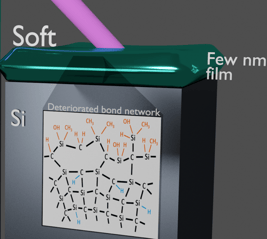 Background: The demand for faster, more efficient, and more compact nanoelectronic devices, like smartphone chips, requires engineers to develop increasingly complex designs. To achieve this, engineers use layer upon layer of very thin films – as thin as only a couple strands of DNA – with impurities added, to tailor the function. However, the presence of these necessary impurities and extreme thinness degrades the material strength, reducing its performance and making it more likely to fail.
Background: The demand for faster, more efficient, and more compact nanoelectronic devices, like smartphone chips, requires engineers to develop increasingly complex designs. To achieve this, engineers use layer upon layer of very thin films – as thin as only a couple strands of DNA – with impurities added, to tailor the function. However, the presence of these necessary impurities and extreme thinness degrades the material strength, reducing its performance and making it more likely to fail.
Ultrafast Laser Science
 Background: Science and technology are inextricably linked and continue to drive each other. Ultrafast lasers have revolutionized our understanding of how molecules and materials work and how charges, spins, phonons and photons interact dynamically. In past research, KMLabs designed Ti:sapphire lasers that operated at the limits of pulse duration and stability, with adjustable pulse durations from 7 fs on up. These lasers are now a standard fixture in thousands of laboratories worldwide. More recently, we developed tabletop high peak-power, high average-power lasers with unprecedented short pulse duration, spanning the UV to the mid-infrared regions of the spectrum.
Background: Science and technology are inextricably linked and continue to drive each other. Ultrafast lasers have revolutionized our understanding of how molecules and materials work and how charges, spins, phonons and photons interact dynamically. In past research, KMLabs designed Ti:sapphire lasers that operated at the limits of pulse duration and stability, with adjustable pulse durations from 7 fs on up. These lasers are now a standard fixture in thousands of laboratories worldwide. More recently, we developed tabletop high peak-power, high average-power lasers with unprecedented short pulse duration, spanning the UV to the mid-infrared regions of the spectrum.
Recommended Sources: Hyperion VUV and Pantheon.
Specifications: multi-kHz to MHz rep rate; 6 to 80 eV; 10 - 300 fs; 40 - 1300 meV linewidth; 1010 - 1014 ph/s flux.



